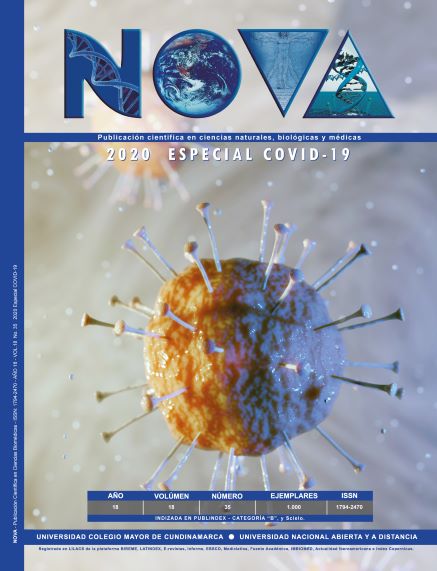NOVA by http://www.unicolmayor.edu.co/publicaciones/index.php/nova is distributed under a license creative commons non comertial-atribution-withoutderive 4.0 international.
Furthermore, the authors keep their property intellectual rights over the articles.
Show authors biography
COVID-19 diagnosis is based on both clinical aspects and screening tests. However, clinical symptoms and signs in infected patients are highly atypical; hence, molecular
tests are essential for diagnosis. RT-qPCR is carried out at BSL II level laboratories; the main molecular targets for viral detection are E gene (envelope), and RdRP gene (RNA-
dependent RNA polymerase). False negatives in this diagnosis are due to sample quality and quantity, transport conditions, storage and handling before and after extraction (RNA
is heat-labile and RNases are abundant); infection phase; virus mutations and presence of CRP inhibitors. Taking into account analytical sensitivity of RT-qPCR (5.2 copies of
RNA / reaction) and the fact that once RNA it is extracted, it progressively degrades and affects test diagnostic sensitivity, a new sample -specifically taken from the lower respiratory
tract in order to increase viral load- is recommended in the abovementioned cases. Timely diagnosis allows optimizing management (isolation and treatment), patient monitoring,
implementing prevention and control measures as well as epidemiological surveillance of the disease.
Article visits 240 | PDF visits 411
Downloads
1. Corman VM, Eckerle I, Bleicker T, Zaki A, Landt O, Eschbach-Bludau M, et al. Detection of a novel human coronavirus by real-time reverse-transcription polymerase chain reaction. Euro Surveill.2012;17(39):20285 doi: https://doi.org/10.2807/ese.17.39.20285-en
2. Drosten C, Gunther S, Preiser W, van der Werf S, Brodt HR, Becker S, et al. Identification of a novel coronavirus in patients with severe acute respiratory syndrome. N Engl J Med. 2003;348(20):1967-76. doi: https://doi.org/ 10.1056/NEJMoa030747
3. Drexler JF, Gloza-Rausch F, Glende J, Corman VM, Muth D, Goettsche M, et al. Genomic characterization of severe acute respiratory syndrome-related coronavirus in European bats and classification of coronaviruses based on partial RNA-dependent RNA polymerase gene sequences. J Virol. 2010;84(21):11336-49. doi: https://doi.org/10.1128/JVI.00650-10
4. Wang W, Xu Y, Gao R, Lu R, Han K, et al. Detection of SARS-CoV-2 in Different Types of Clinical Specimens. JAMA. 2020;323(18):1843-4. doi: https://doi.org/10.1001/jama.2020.3786
5. Sociedad Española de Enfermedades Infecciosas y Microbiología Clínica. Recomendaciones institucionales. Documento de posicionamiento de la SEIMC sobre el diagnóstico microbiólogo de Covid-19. [Consultado el 26 de marzo de 2020]. Disponible en https://seimc.org/contenidos/documentoscientificos/recomendaciones/seimc-rc-2020-Posicionamiento_SEIMC_diagnostico_microbiologico_COVID19.pdf
6. Organización Mundial de la Salud. Laboratory testing for 2019 novel coronavirus (2019-nCoV) in suspected human cases.Interim guidance. 19 March 2020. [Consultado el 31 de marzo de 2020]. Disponible en: https://www.who.int/publications/i/item/10665-331501
7. Centers for Disease Control and Prevention. Interim Guidelines for Collecting, Handling, and Testing Clinical Specimens from Persons for Coronavirus Disease2019 (COVID-19). [Consultado el 28 de marzo de 2020]. Disponible en: https://www.cdc.gov/coronavirus/2019-nCoV/lab/guidelines-clinical-specimens.html
8. Wang W, Xu Y, Gao R, Lu R, Han K, et al. Detection of SARS-CoV-2 in Different Types of Clinical Specimens. JAMA. 2020;323(18):1843-44. doi: https://doi.org/10.1001/jama.2020.3786
9. Argoty LA. Instituto Nacional de Salud Micrositio [Consultado el 19 marzo de 2020] Disponible en: http://www.ins.gov.co/Noticias/Paginas/Coronavirus.aspx
10. Loeffelholz MJ, Tang YW. Laboratory diagnosis of emerging human coronavirus infections – The state of the art. Emerg Microbes Infect. 2020;9(1):747-756. doi: https://doi.org/10.1080/22221751.2020.1745095
11. SEIMC. Reflexiones de SEIMC sobre el uso de la detección de antígenos y anticuerpos para diagnóstico de COVID-19. 30 de marzo de 2020. Disponible en: https://seimc.org/contenidos/noticias/2020/seimc-nt-2020 Reflexiones_deteccion_Ag_y_AC_COVID-19.pdf. Consultado 9 abril 2020
12. Lineamientos para el uso de pruebas en el laboratorio de salud pública (LSP) en el marco de la emergencia sanitaria por (Covid-19) en Colombia. Ministerio de Salud y Protección Social Bogotá, abril de 2020. [Consultado el 24 de junio de 2020]. Disponible en: https://www.minsalud.gov.co/RID/lineamientos-pruebas-lsp-covid-19.pdf
13. Corman V M, Landt, O, Kaiser M, et al. Detection of 2019 novel coronavirus (2019-nCoV) by real-time RT-PCR. Euro Surveillance : Bulletin Europeen Sur Les Maladies Transmissibles = European Communicable Disease Bulletin. 2020;25(3), 1–8. https://doi.org/10.2807/1560-7917.ES.2020.25.3.2000045
14. Gomez J, Castellanos J, Rodriguez A, Cardona J, Forero JE, Mattar S, Esparza G. Consenso de grupo Ad-hoc sobre recomendaciones para la evaluación y controles de calidad para el diagnóstico molecular y serológico de la infección humana por SARS CoV-2. Infectio, 2020;24(3):S2
15. CNBC FDA grants ‘emergency use’ coronavirus test that can deliver results in 45 minutes. 21 Mar 2020. [Consultado el 31 de marzo de 2020]. Disponible en https://www.cnbc.com/2020/03/21/fda-grants-emergencyuse-corona-virus-test-that-can-deliver-results-in-45-minutes.html






